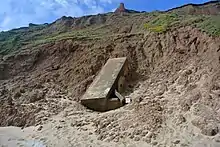Boulder clay
Boulder clay is a geological deposit of clay, often full of boulders, which is formed out of the ground moraine material of glaciers and ice-sheets. It was the typical deposit of the Glacial Period in northern Europe and North America.


Boulder clay is distinguished from other clay in that it contains more boulders. The clay is scraped from the top layer of older rock by the movement of a glacier or ice sheet. An ice sheet pushes rocks, boulders and everything else in its path, which in turn wears the rock into silt-like grain, which makes up the clay. Clay formed out of Old Red Sandstone areas is red, over Carboniferous rocks it is often black, over Silurian rock it may be buff or grey, and where the ice has passed over chalk, the clay may be quite white and chalky (chalky boulder clay). Much boulder clay is of a bluish-grey until exposed to weather, which transforms it to a brown colour.
Boulder clay is classed with a group of poorly sorted materials, described by the general term diamicton. It is usually a stiff, tough clay devoid of stratification, though some varieties are distinctly laminated. Occasionally, within the boulder clay, there are irregular lenticular masses of more or less stratified sand, gravel or loam.
The boulders are held within the clay in an irregular manner, and they vary in size from pebbles up to masses many tons in weight. Usually they are somewhat oblong, and often they possess a flat side or sole; they may be angular, sub-angular, or well-rounded. If they are hard rocks, they frequently bear grooves and scratches caused by contact with other rocks while held firmly in the moving glacier ice. Like the clay in which they are borne, the boulders belong to districts over which the ice has travelled; in some regions they are mainly limestones or sandstones; in others they are granite, basalts, gneisses, etc.; they may consist of any hard rock. By the nature of the contained boulders, it is often possible to trace the path along which a vanished ice-sheet moved; thus in the glacial drift of the east coast of England, many Scandinavian rocks can be recognized.[1]
With the exception of foraminifera, which have been found in the boulder clay of widely separated regions, fossils are practically unknown. In some maritime districts, marine shells have been incorporated with the clay.[1]
A classic example of boulder clay can be seen in England at the rapidly eroding cliffs of Hornsea, situated along the Holderness coast in East Yorkshire.
See also
References
-
 One or more of the preceding sentences incorporates text from a publication now in the public domain: Chisholm, Hugh, ed. (1911). "Boulder Clay". Encyclopædia Britannica. 4 (11th ed.). Cambridge University Press. pp. 319–320.
One or more of the preceding sentences incorporates text from a publication now in the public domain: Chisholm, Hugh, ed. (1911). "Boulder Clay". Encyclopædia Britannica. 4 (11th ed.). Cambridge University Press. pp. 319–320.
